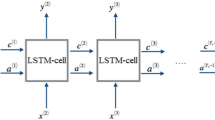Abstract
Load forecasting can increase the efficiency of modern energy systems with built-in measuring systems by providing a more accurate peak power shaving performance and thus more reliable control. An analysis of an integrated CO2 heat pump and chiller system with a hot water storage system is presented in this paper. Drastic power fluctuations, which can be reduced with load forecasting, are found in historical operation records. A model that aims to forecast the ventilation system heating demand is thus established on the basis of a long short-term memory (LSTM) network. The model can successfully forecast the one-hour-ahead power using records of the past 48 h of the system operation data and the ambient temperature. The mean absolute percentage error (MAPE) of the forecast results of the LSTM-based model is 10.70%, which is respectively 2.2% and 7.25% better than the MAPEs of the forecast results of the support vector regression based and persistence method based models.
Similar content being viewed by others
References
SHAHNAZARI H, MHASKAR P, HOUSE J M, et al. Heating, ventilation and air conditioning systems: Fault detection and isolation and safe parking [J]. Computers & Chemical Engineering, 2018, 108: 139–151.
HUANG Y, NIU J L. A review of the advance of HVAC technologies as witnessed in ENB publications in the period from 1987 to 2014 [J]. Energy and Buildings, 2016, 130: 33–45.
SONG M J, MAO N, XU Y J, et al. Challenges in, and the development of, building energy saving techniques, illustrated with the example of an air source heat pump [J]. Thermal Science and Engineering Progress, 2019, 10: 337–356.
MARUYAMA K, YOON G, WATANABE T. Simple thermal energy storage tank for improving the energy efficiency of an existing air-conditioning system [J]. IOP Conference Series: Earth and Environmental Science, 2019, 238: 012057.
BEGHI A, CECCHINATO L, RAMPAZZO M, et al. Load forecasting for the efficient energy management of HVAC systems [C]//Proceedings of the 2010 IEEE International Conference on Sustainable Energy Technologies. Piscataway: IEEE, 2010: 1–6.
PAPALEXOPOULOS A D, HESTERBERG T C. A regression-based approach to short-term system load forecasting [J]. IEEE Transactions on Power Systems, 1990, 5(4): 1535–1547.
VU D H, MUTTAQI K M, AGALGAONKAR A P. Short-term load forecasting using regression based moving windows with adjustable window-sizes [C]//Proceedings of the 2014 IEEE Industry Application Society Annual Meeting. Piscataway: IEEE, 2014: 1–8.
CHO M Y, HWANG J C, CHEN C S. Customer short term load forecasting by using ARIMA transfer function model [C]//Proceedings of the 1995 International Conference on Energy Management and Power Delivery. Piscataway: IEEE, 1995: 317–322.
LEE C M, KO C N. Short-term load forecasting using lifting scheme and ARIMA models [J]. Expert Systems with Applications, 2011, 38(5): 5902–5911.
JAIN R K, SMITH K M, CULLIGAN P J, et al. Forecasting energy consumption of multi-family residential buildings using support vector regression: Investigating the impact of temporal and spatial monitoring granularity on performance accuracy [J]. Applied Energy, 2014, 123: 168–178.
LI Q, MENG Q L, CAI J J, et al. Predicting hourly cooling load in the building: A comparison of support vector machine and different artificial neural networks [J]. Energy Conversion and Management, 2009, 50(1): 90–96.
FAN C, XIAO F, WANG S W. Development of prediction models for next-day building energy consumption and peak power demand using data mining techniques [J]. Applied Energy, 2014, 127: 1–10.
ZHAO D Y, ZHONG M, ZHANG X, et al. Energy consumption predicting model of VRV (variable refrigerant volume) system in office buildings based on data mining [J]. Energy, 2016, 102: 660–668.
LECUN Y, BENGIO Y, HINTON G. Deep learning [J]. Nature, 2015, 521(7553): 436–444.
KONG W C, DONG Z Y, JIA Y W, et al. Short-term residential load forecasting based on LSTM recurrent neural network [J]. IEEE Transactions on Smart Grid, 2019, 10(1): 841–851.
CAI M M, PIPATTANASOMPORN M, RAHMAN S. Day-ahead building-level load forecasts using deep learning vs. traditional time-series techniques [J]. Applied Energy, 2019, 236: 1078–1088.
MOHAMED A R, DAHL G E, HINTON G. Acoustic modeling using deep belief networks [J]. IEEE Transactions on Audio, Speech, and Language Processing, 2012, 20(1): 14–22.
HINTON G, DENG L, YU D, et al. Deep neural networks for acoustic modeling in speech recognition: The shared views of four research groups [J]. IEEE Signal Processing Magazine, 2012, 29(6): 82–97.
KINGMA D P, BA J L. Adam: A method for stochastic optimization [EB/OL]. [2019-12-31]. https://arxiv.org/pdf/1412.6980.pdf.
Author information
Authors and Affiliations
Corresponding author
Additional information
Foundation item: the Special Program for Innovation Methodology of the Ministry of Science and Technology of China (No. 2016IM010100)
Rights and permissions
About this article
Cite this article
Zhang, Z., Zhang, Z., Eikevik, T.M. et al. Ventilation System Heating Demand Forecasting Based on Long Short-Term Memory Network. J. Shanghai Jiaotong Univ. (Sci.) 26, 129–137 (2021). https://doi.org/10.1007/s12204-021-2277-5
Received:
Accepted:
Published:
Issue Date:
DOI: https://doi.org/10.1007/s12204-021-2277-5




